ARIZONA
After New Year’s festivities in California, we returned to Arizona and immersed ourselves in square dancing. But, we also had to get ready for our trip to Antarctica. Just after Christmas, we booked our long talked about trip to the White Continent, and we were leaving on January 25th. So, with one more quick trip to California to celebrate the 50th Wedding Anniversary of our friends, the Coopers, we returned with one day for final packing before departing. We had gloves and scarves and hats and long underwear and lots of other "stuff." Plus we brought formal wear for two formal nights on the Marco Polo. Talk about baggage!
BUENOS AIRES
We finally got it all together and left for the airport bright and early on
the 25th. Our first stop was Los Angeles, then on to Chicago, then
non-stop to Buenos Aires. Approximately forty hours from our home to the hotel!
I’m too old for this stuff. Ray, of course, slept on the plane so was raring to
go, while I just wanted to crash. We went out for a quick dinner, then I went to
bed. Ray went out walking the area, which it turns out was not a smart move. The
character of the town changes considerably after dark when the tourists are
safely tucked into their hotels.
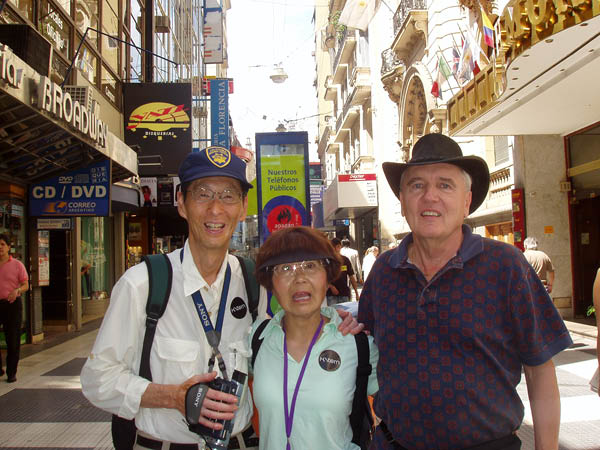 The next morning, after a horrible breakfast at our Sheraton Four Points
Hotel, we went exploring. One of the must-see touristy things is Florida
Street, a huge pedestrian mall with shopping at the most exclusive American
and European designer boutiques and at little dollar-type stores. The street was
teeming with hawkers, locals and tourists. We stopped to watch some street
dancers doing the tango. When they finished, the crowd was breaking up, and I
felt a tap on my shoulder. When I turned around, there were some square dance
friends from California. They were on a four-month world cruise and were in
Buenos Aires for that day only! What are the odds? THAT’S ONE!
The next morning, after a horrible breakfast at our Sheraton Four Points
Hotel, we went exploring. One of the must-see touristy things is Florida
Street, a huge pedestrian mall with shopping at the most exclusive American
and European designer boutiques and at little dollar-type stores. The street was
teeming with hawkers, locals and tourists. We stopped to watch some street
dancers doing the tango. When they finished, the crowd was breaking up, and I
felt a tap on my shoulder. When I turned around, there were some square dance
friends from California. They were on a four-month world cruise and were in
Buenos Aires for that day only! What are the odds? THAT’S ONE!
Buenos Aires was originally founded in 1536 by Pedro de Mendoza, who was
commissioned by the Holy Roman Emperor, Charles V. By 1541 they abandoned this
settlement, and forty years later the Spanish conquistador, Juan de Garay
refounded the city. By the 18th century Buenos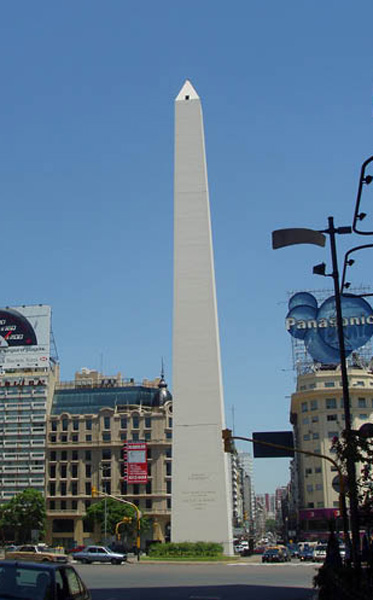 Aires had street
lamps, cobblestone streets and a printing press. In 1816 Argentina won its
freedom from Spain, but civil strife continued for many years. The city today is
a typical urban center with elegant neighborhoods and very poor areas. Since it
is their summer, the temperature climbed to Arizona heights in the afternoon, so
we squeezed our sightseeing in quick doses.
Aires had street
lamps, cobblestone streets and a printing press. In 1816 Argentina won its
freedom from Spain, but civil strife continued for many years. The city today is
a typical urban center with elegant neighborhoods and very poor areas. Since it
is their summer, the temperature climbed to Arizona heights in the afternoon, so
we squeezed our sightseeing in quick doses.
The world’s widest street (400 feet), Avenida 9 de Julio, is a tangle
of cars, pedestrians, police and traffic signals. It also boasts the Obelisk.
This 220 foot high obelisk was built in 1936. Each side of the obelisk
commemorates an historic event of the city--the 4th centennial of the city's
foundation by Pedro de Mendoza; the place where the Argentine flag fluttered for
the first time; the second foundation of the city by Juan de Garay; and the
proclamation of the City as the Federal Capital of the country.
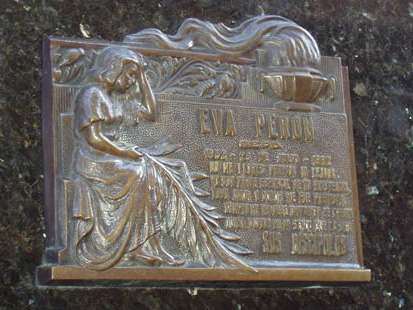 La Recoleta Cemetery is like New Orleans cemeteries with tombs and
mausoleums above ground. It was a church graveyard until 1882 when the governor
opened it to the general public and renamed it Cemetery of the North.
It sits on the city's most valuable land and is the final resting place of
many illustrious people. Evita Peron’s tomb is here, and hence, a must see for
American tourists who are either Andrew Lloyd Webber or Madonna fans. Materials
used in the construction of tombs between 1880 and 1930 were imported from Paris
and Milan, and many important sculptures enhance the tombs. Apparently some of
the tombs are worth upwards of a million dollars. Some were in very poor repair,
and we saw several people working on refurbishing–not workmen, but owners on
do-it-yourself projects.
La Recoleta Cemetery is like New Orleans cemeteries with tombs and
mausoleums above ground. It was a church graveyard until 1882 when the governor
opened it to the general public and renamed it Cemetery of the North.
It sits on the city's most valuable land and is the final resting place of
many illustrious people. Evita Peron’s tomb is here, and hence, a must see for
American tourists who are either Andrew Lloyd Webber or Madonna fans. Materials
used in the construction of tombs between 1880 and 1930 were imported from Paris
and Milan, and many important sculptures enhance the tombs. Apparently some of
the tombs are worth upwards of a million dollars. Some were in very poor repair,
and we saw several people working on refurbishing–not workmen, but owners on
do-it-yourself projects.
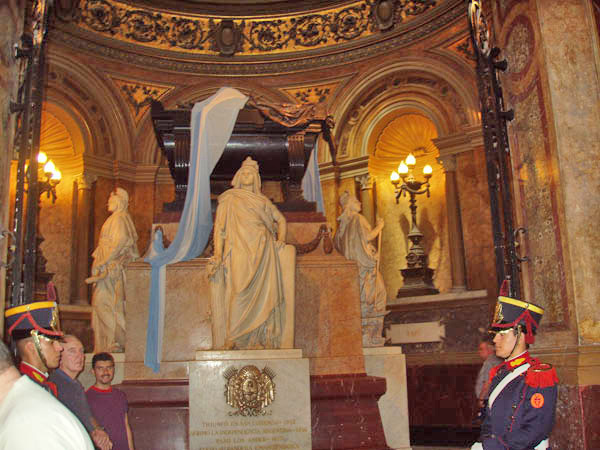 The Metropolitan Cathedral, completed in 1862, has a Renaissance plan of a Latin Cross, with a tiled dome, and three naves. Paintings and sculptures of 18th century European artists and a Peruvian baroque altarpiece adorn the interior. A columned facade was filled with beggars seeking alms from touristas and shade from the sun when we visited. In an alcove a mausoleum houses the ashes of the Great Liberator, General José de San Martín. Uniformed guards protect his remains. This Argentine hero led battles against Spanish armies that led to Argentina’s independence.
The Metropolitan Cathedral, completed in 1862, has a Renaissance plan of a Latin Cross, with a tiled dome, and three naves. Paintings and sculptures of 18th century European artists and a Peruvian baroque altarpiece adorn the interior. A columned facade was filled with beggars seeking alms from touristas and shade from the sun when we visited. In an alcove a mausoleum houses the ashes of the Great Liberator, General José de San Martín. Uniformed guards protect his remains. This Argentine hero led battles against Spanish armies that led to Argentina’s independence.
The May Pyramid erected on May 25, 1811 commemorates the Revolution of May 1810. Originally this was a 50 foot obelisk of adobe bricks surrounded by railings; an 1856 remodel 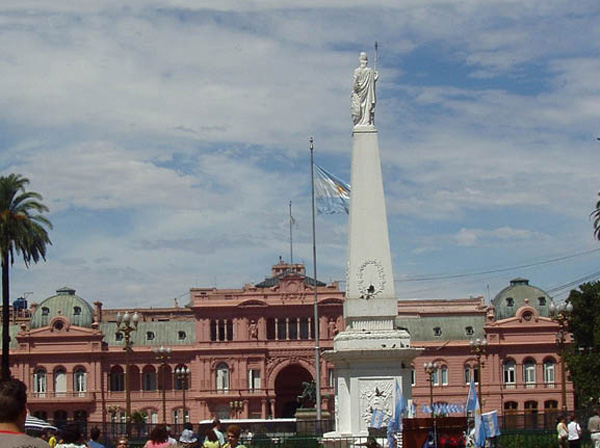 added bricks and plaster, a woman symbolizing the new Republic on top, and allegorical sculptures around the bottom. The original pyramid remains intact inside the remodeled one.
added bricks and plaster, a woman symbolizing the new Republic on top, and allegorical sculptures around the bottom. The original pyramid remains intact inside the remodeled one.
The pyramid sits in front of Casa Rosada (Pink House). A government building built in 1580. During a 19th century reconstruction, it was painted pink to combine the colors of the two political sectors at the time--red for the federals and white for the unitaries. It is huge building and very, very pink!
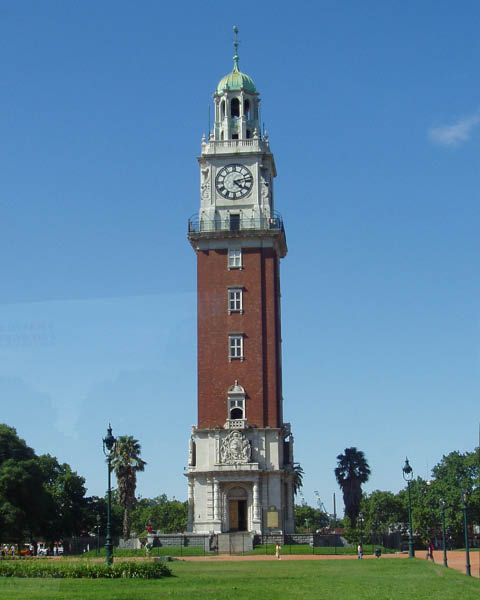 Torre de los Ingleses is in the center of the Plaza Britannia. It
was built by British residents in commemoration of the centennial of the
Revolution of May and was inaugurated on May 24, 1916. All the parts were
brought from England. The main door bears the inscription, "To the great
Argentine people, the British residents, cheers, May 25 1810-1910." Following
the 1982 Falklands war with Britain, the tower changed its name from "Torre de
los Ingleses" (The British Tower) to "Torre Monumental" (Monumental Tower) and
the plaza is no longer Plaza Britannia.
Torre de los Ingleses is in the center of the Plaza Britannia. It
was built by British residents in commemoration of the centennial of the
Revolution of May and was inaugurated on May 24, 1916. All the parts were
brought from England. The main door bears the inscription, "To the great
Argentine people, the British residents, cheers, May 25 1810-1910." Following
the 1982 Falklands war with Britain, the tower changed its name from "Torre de
los Ingleses" (The British Tower) to "Torre Monumental" (Monumental Tower) and
the plaza is no longer Plaza Britannia.
The colorful La Boca district was built by its residents, mostly Italians, using leftover materials and paint from the ships they worked on. Soccer enthusiasts seem to know about their team, Boca Juniors. La Boca was home to several prominent Argentine artists. Calle Caminito is the tourist stop where street dancers tango and tourist shops abound.
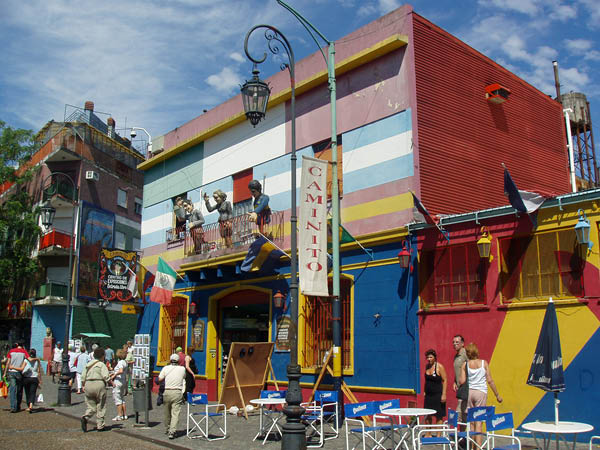 It was in La Boca at the end of the 19th century that the
sensual and risqué Argentine tango emerged. Like "dirty dancing" it was not an
acceptable dance for the upper classes, but the tango became a European craze
and hence was accepted by all classes. A writer describes it this way,
It was in La Boca at the end of the 19th century that the
sensual and risqué Argentine tango emerged. Like "dirty dancing" it was not an
acceptable dance for the upper classes, but the tango became a European craze
and hence was accepted by all classes. A writer describes it this way,
A mixture of passion, sensuality, nostalgia, and melancholy, the tango is the dance of Argentina and, more specifically, Buenos Aires. Every child learns it; every couple knows it.
Armed with the information on this dance, we attended one of the many Tango Dance shows in Buenos Aires. It was a trip with the cruise line, so we were seated at tables with various strangers. Get-acquainted conversations were rippling around the table, when the woman across from us mentioned she now lived in Sun City, Arizona but was originally from Chicago. ZING!
Now with almost three million people in Chicago, you’d think we wouldn’t ask the obvious question, "Where in Chicago are you from?"
But we did, and she answered, "Deerfield." Well, now we were getting things narrowed down (only 20,000 in Deerfield), so we said, "So did we."
"What street?" she replied.
Ray countered with, "You wouldn’t know it, the lane was just a little short, private street."
Anyway, turns out the house in Deerfield that we purchased in 1977 was built by this woman and her husband in the 1950's. THAT’S TWO!
So, ONE and TWO are my Argentinian small world stories. We have others from the past. They're so much fun to tell.
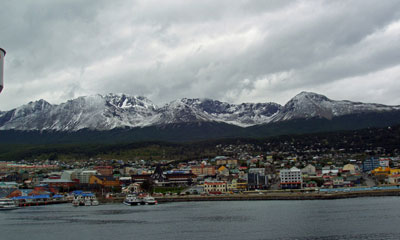 USHUAIA, PATAGONIA, ARGENTINA
USHUAIA, PATAGONIA, ARGENTINA
Our warm weather time was up, and we headed to the airport for our flight to Ushuaia, where we would board our ship, the Marco Polo. We traveled by Argentina Airlines for this four hour flight of 1800 miles, and we traveled first class. It was the luck of the draw and was very posh. The food was great, and the champagne wasn’t too bad either. Anyway, we arrived to nippy temperatures and overcast skies. But never fear, we were prepared.
Ushuaia is the southernmost city in the world, and the people in the area live tax-free. This was one of the incentives offered by the Argentine government to those willing to settle this area. The town is tiny, and most supplies must be shipped in. Everyone we met seemed to enjoy living there, and one of our guides said the weather was quite balmy for that time of the year. It was the Argentine summer, and temperatures were in the 50's.
THE MARCO POLO
We boarded our ship, stowed our gear, and it was time for dinner and the evening show. Our dinner companions were two VERY southern LOL’s from North Carolina who, like some of our friends, apparently cruise constantly with short breaks to visit their landlocked home. They were really kind of cute. Onboard we received our bright RED parkas which were mandatory gear for all departures. I think they made us easy to find in case we fell out of the zodiacs. Our special life vests were also a bright red.
ANTARCTICA
We sailed into the Beagle Channel and cruised Drake’s Passage during the night. Now, think back to your fourth grade history and geography classes, and you’ll remember these. The Beagle Channel is named after the HMS Beagle on which a young Charles Darwin sailed in 1831-32. His scientific notes and fossil collections culminated in his 1839 publication of The Voyage of the Beagle, a four volume work which gave him prominence in the scientific world. From the channel we sailed into Drake’s Passage, the body of water between the southern tip of South America at Cape Horn and the South Shetland Islands of Antarctica. The passage is part of the Southern Ocean and is named after Sir Francis Drake, who never actually sailed through it. He chose the calmer route of the Strait of Magellan. Since we traversed it at night, Ray was saved from most of the bumpy crossing.
 We awoke the next morning to glorious sunshine. We cruised into Deception Island in early morning and sailed through the narrow entrance to this flooded caldera. The island is an active volcano with its most recent eruption in 1970. The island is horseshoe shaped and surrounded by snow-capped peaks. It was breathtaking.
We awoke the next morning to glorious sunshine. We cruised into Deception Island in early morning and sailed through the narrow entrance to this flooded caldera. The island is an active volcano with its most recent eruption in 1970. The island is horseshoe shaped and surrounded by snow-capped peaks. It was breathtaking.
Our first zodiac experience was not a landing but a little cruise around Cuverville Island, where we dodged icebergs and had our first sighting of penguins. Over 10,000 gentoo penguins are known to inhabit the island, along with a few other varieties. Large hunting birds also nest on the island and hunt around the penguin colony. Seals were resting on some of the icebergs we passed. The water was as smooth as glass, and we were warm in our parkas and thermals.
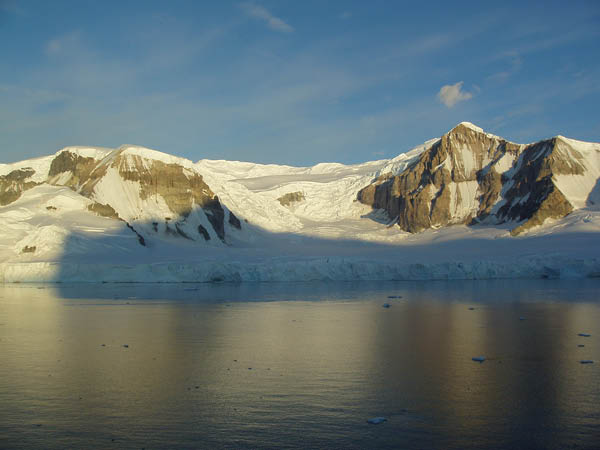 A team of eight scientists accompanied us on shipboard, each with a different area of expertise. Daily lectures introducing us to elements of the trip enriched our onboard experience. Several members of the expedition team were always present on the rear deck of the ship to aid in sighting whales, birds, or whatever. Passengers could ask questions at any time. Various hot beverages and refreshments were always available from some very cold looking servers, and ice cream treats from the adjacent café were on available at meal time without needing refrigeration. A daily posting of animals and birds sighted was in the reception area, and we were each given a copy at the end of the cruise. Over sixty varieties of birds were sighted along with six different types of whales, various seals, dolphins and sea lions.
A team of eight scientists accompanied us on shipboard, each with a different area of expertise. Daily lectures introducing us to elements of the trip enriched our onboard experience. Several members of the expedition team were always present on the rear deck of the ship to aid in sighting whales, birds, or whatever. Passengers could ask questions at any time. Various hot beverages and refreshments were always available from some very cold looking servers, and ice cream treats from the adjacent café were on available at meal time without needing refrigeration. A daily posting of animals and birds sighted was in the reception area, and we were each given a copy at the end of the cruise. Over sixty varieties of birds were sighted along with six different types of whales, various seals, dolphins and sea lions.
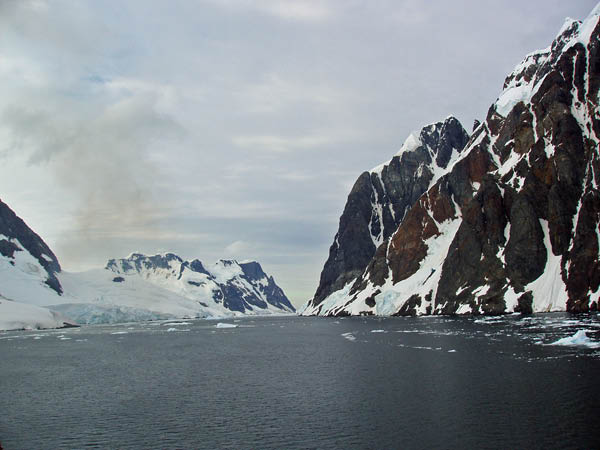
February
![]()
ANTARCTICA CONT'D
We were scheduled to arrive at the LeMaire Channel at 7:30 a.m., so we rose early and headed outside to view this glacier lined passage billed as one of Antarctica’s most beautiful. But, alas, ice was blocking the narrow passage, and we had to circumnavigate another way through the archipelago. Views from the entrance to the passage were majestic indeed. Because we had to wait for another ship to turn around and come out of the passage, we spent quite a while there enjoying our surroundings.
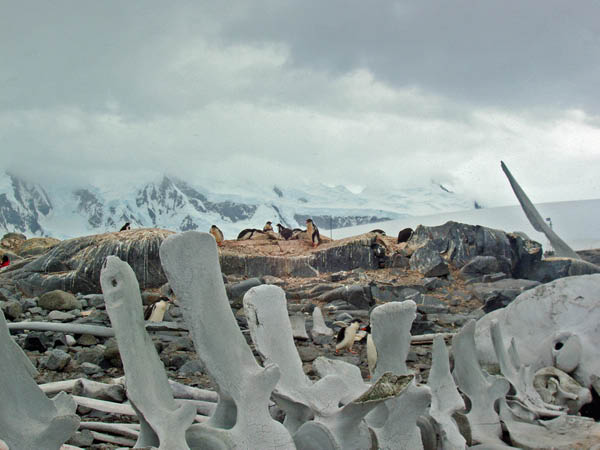
Port Lockroy is home to over 4000 Gentoo penguins, and our first landing in Antarctica brought us face to face and nose to nose with these guys. The weather was not quite as cooperative as it had been for our little caldera cruise earlier, and the zodiac driver seemed to enjoy it, saying, “Now this is the REAL Antarctica.”
The huge skeleton of a whale lay on the water’s edge and gave us an idea of the scale of these giants of the sea. The abundance of whales in this region made it a station for whalers during their heyday, and it is estimated that 3,000 great whales were cut up here for their oil and other products during the whaling era.
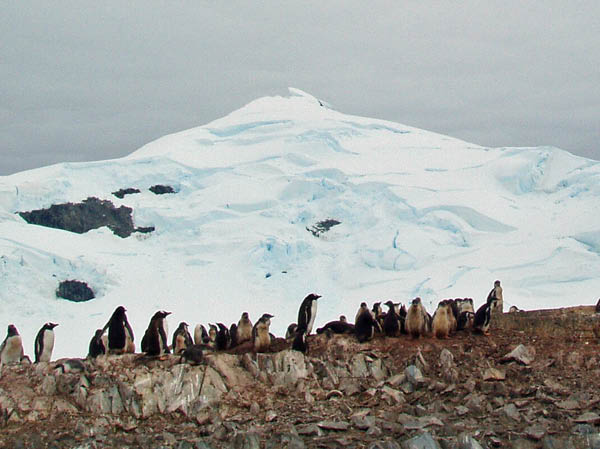 Paradise Harbor, our next stop, was first surveyed by a Belgian Antarctic Expedition in 1897-1899. Then in 1921-1922 two scientists studying penguins lived here on a waterboat, and the name Waterboat Point is how it is still known. It is now a Chilean Station, and here we saw the only buildings anywhere in Antarctica–and yes, they had a tiny souvenir shop. Gentoo penguins nest here in great numbers also. Seals are found on surrounding rocks and icebergs and whales still swim in the surrounding waters.
Paradise Harbor, our next stop, was first surveyed by a Belgian Antarctic Expedition in 1897-1899. Then in 1921-1922 two scientists studying penguins lived here on a waterboat, and the name Waterboat Point is how it is still known. It is now a Chilean Station, and here we saw the only buildings anywhere in Antarctica–and yes, they had a tiny souvenir shop. Gentoo penguins nest here in great numbers also. Seals are found on surrounding rocks and icebergs and whales still swim in the surrounding waters.
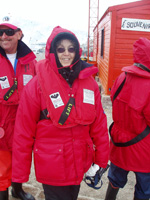 |
Here we are in our Antarctic gear. Everything man made in Antarctica was red--see the building in the background. In the photo of Ray you can see the ship in the background and the ice pack behind it. It gives you an idea of the size of the ice walls we traveled through. | 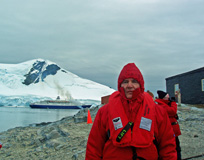 |
Several whales were seen that day, and no matter how often I see them, it still gives me a rush. Birds were abundant, and we even saw some scouting among the penguins for their lunch. We also saw one devouring his lunch. Yuck.
The first recorded visit to Half Moon Island was in February 1820 by an American sealer, Nathaniel Palmer. Our visit was in February 2006, 176 years later, and I bet it hasn’t changed a great deal in that amount of time. There aren’t too many places in the world that you can say that about, but Antarctica is rare. The island’s inhabitants included Chinstrap penguins. The guy on the right is a Chinstrap, and you can see why if you look closely. The Gentoo, which we saw several times earlier, is on the left.
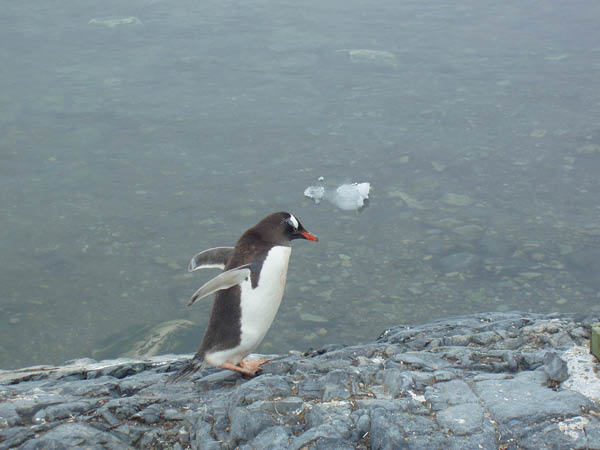 |
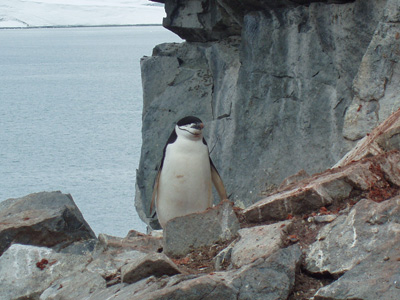 |
We sadly finished our visit to the white continent and headed back through the Drake Passage and around Cape Horn for a second time.
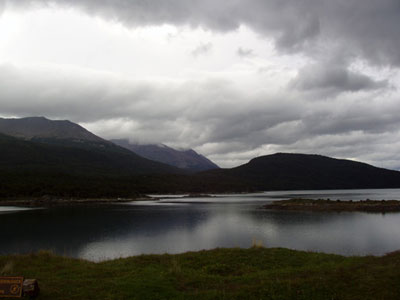 Back in Patagonia, we visited the main street in Ushuaia, and did a little shopping. Our time on the ship was over, and we were packed and waiting to go. But first...A quick trip to an Argentine National Park showed us some more breathtaking scenery on the island, Tierra del Fuego, where Ushuaia is located.
Back in Patagonia, we visited the main street in Ushuaia, and did a little shopping. Our time on the ship was over, and we were packed and waiting to go. But first...A quick trip to an Argentine National Park showed us some more breathtaking scenery on the island, Tierra del Fuego, where Ushuaia is located.
Our flight home was uneventful, but long. After getting sick the last few days of our trip, the flight just about did me in. I managed to share it with Ray, so he wouldn't feel left out.
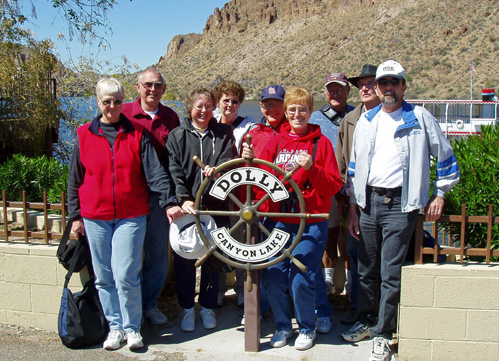 March - April
March - April
![]()
Square dance friends and activities kept us busy through the end of March. We also saw some local shows and enjoyed a boat trip with friends on nearby Canyon Lake. Then at the end of March everything came to a halt. We had to face up to doing some work around the homestead, no more excuses, fun time was over. The yard needed some tending, so Ray worked on that with a vengeance, and I tried to catch up with things inside–computer work, genealogy, and plain old housework. The desert was coming into bloom and was alive with color during these months.
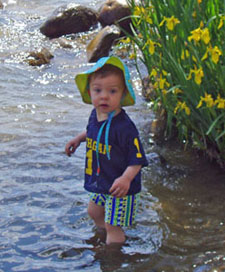 May - June
May - June
![]()
Ray spent the early part of May driving back and forth to Tucson. His mother was in and out of the hospital and a rehab center several times. I was back at Trilogy working with a group to form a genealogy club. We also had time to visit with some friends who remain in the desert for the summer. When Ray’s mother was back at home and doing nicely, we packed up for the summer.
Son, Paul, and Robyn just moved to a new home in Michigan. They looked for quite a while because they wanted one with running water, outside that is, for their boat. We hoped to arrive in time to help them move, but by driving longer days than usual, we made it in time to babysit while they settled in. When we arrived, they had one of the hottest spells in several years, so it felt like we had never left Arizona. Grandson, Keegan, was sixteen months old and into all the good stuff packed in boxes around the house. Mostly, though, like most sixteen month olds, he liked the boxes. We had a great visit before we left for Pittsburgh.
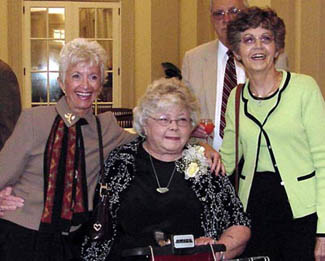 A very dear friend from college was retiring from the faculty at the University of Pittsburgh, and we went to join the festivities. Well, not only did we get festivities, but also got to see another college chum whom I hadn’t seen in possibly thirty years. We had a great time celebrating, eating, visiting, eating, sightseeing, eating. You get the picture. I’m not sure Ray had a great time while we reminisced and caught up on each others’ lives, but he is always a good sport. We stayed at a campground just outside the city on a mountaintop looking down into the rolling valleys of Pennsylvania.
A very dear friend from college was retiring from the faculty at the University of Pittsburgh, and we went to join the festivities. Well, not only did we get festivities, but also got to see another college chum whom I hadn’t seen in possibly thirty years. We had a great time celebrating, eating, visiting, eating, sightseeing, eating. You get the picture. I’m not sure Ray had a great time while we reminisced and caught up on each others’ lives, but he is always a good sport. We stayed at a campground just outside the city on a mountaintop looking down into the rolling valleys of Pennsylvania.
From Pittsburgh we went to the Advanced and Challenge Square Dance convention in Ohio, where we danced and visited with more friends, and, once again, had a great time.
When the dancin’ was done, we headed our motor home west and drove to the Bay Area in record time. Again, not our favorite kind of traveling, but for the 50th wedding anniversary of good friends, we put the petal to the metal.
 We attended the party, visited with family and played with grandkids, whose unbounding energy usually wears us out quickly. Ray keeps up with Rico as well as possible, but playing ball endlessly doesn't wear out a five year old as quickly as it does his grandpa. Being in a dfferent state from grandkids is difficult, as we try to catch up with everything during our visits. We left after a couple of weeks ready to resume our solitary life on the road.
We attended the party, visited with family and played with grandkids, whose unbounding energy usually wears us out quickly. Ray keeps up with Rico as well as possible, but playing ball endlessly doesn't wear out a five year old as quickly as it does his grandpa. Being in a dfferent state from grandkids is difficult, as we try to catch up with everything during our visits. We left after a couple of weeks ready to resume our solitary life on the road.
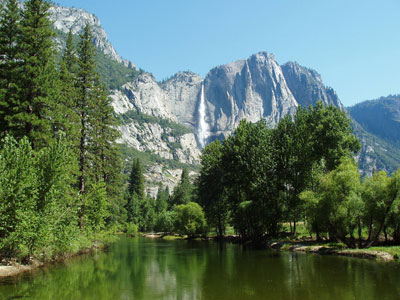 July - August
July - AugustWe decided to hop on down to Yosemite and catch the waterfalls while they still had some water in them, so we booked a week at the resort where we normally stay. BIG mistake! The waterfalls were beautifully full, but so was the park, and temperatures were hovering around three figures during the day. Our time in Yosemite was spent on tree lined paths or in shadowed valleys. A cooling lunch at the Ahwanee was a nice interlude, but the rest of the time we hung around in the motor home with the air conditioner on full blast.
We made a few more miscalculations in our travels as the temperatures continued to soar around the country. We finally had enough and headed to the coast. Arrived in Trinidad, California where the temperatures were a high of 65-70 during the day and cool 50s at night. There we stayed, moving up the coast gradually until we met friends in Coos Bay, Oregon the early part of August.
Our Coos Bay visit was great, as always. The hunters/fishers brought in plenty of fresh crab and a great deal of fish, so we had a fish fry, fresh crab and cioppino. The gatherers/cooks prepared the bounty and some non-caught meals. Shopping in Oregon is always a priority because of the lack of sales tax, so the gatherers did some of that, too. We played a lot of pinochle while not visiting and eating. Some folks headed home from there, others, like us, lingered on the coast for more cool days.
.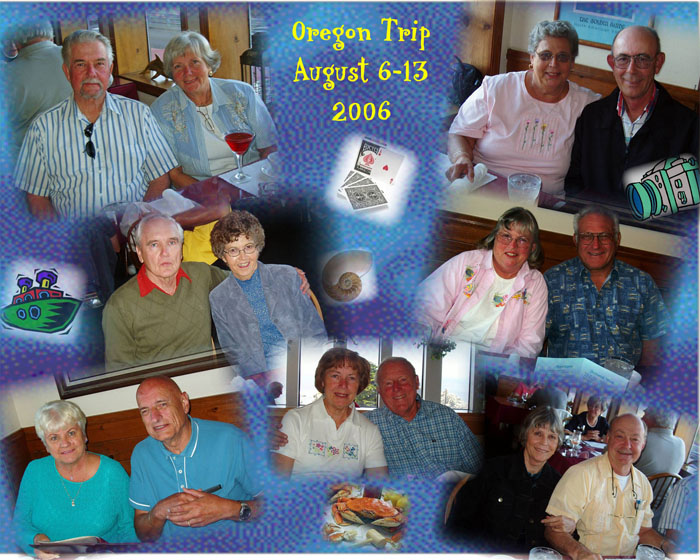
Clockwise from upper right: Perry, Francis, Lewis, Holst, Terry, Tennison, Burton.